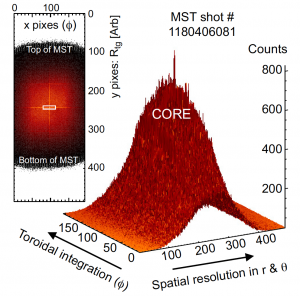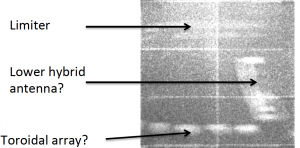
A collaboration between Dr. Luis? Delgado-Aparicio (Princeton Plasma Physics Laboratory), Dr. Lisa Reusch, and Dr. Daniel Den Hartog (UW-Madison) has successfully installed and operated a new soft-x-ray camera based on the Pilatus3 detector made by DECTRIS Laboratories in Switzerland. The detector has the novel features of using a thick silicon layer bonded to a 100k pixel CMOS detector and per-pixel control of the pulse height comparator providing sharp energy thresholding. A pinhole in front of the detector allows it to be used as an x-ray camera with extremely high spatial resolution.? The combination of a large number of pixels with individual energy settings allows the camera to be operated with both high spatial and spectral? resolution enabling it to function as a high resolution Multi-Energy Soft-X-ray (ME-SXR) detector.
This ability to simultaneously set multiple energy thresholds enables ? simultaneous measurement of both continuum and line emission features in the 2-8 keV range where highly-charged ions contribte to the emission spectrum. The camera was installed in? the spring of 2018, and the first data collected with the system is shown in Figure 10. It shows the number of counts generated from x-ray photons with energy greater than? 4 keV. These x-rays were created by thermal electrons in a 500 kA MST discharge.

To get a sense of the spatial resolution o? f the camera, images were taken when fast electrons from the plasma were striking objects on the wall of the vessel, lighting them up with x-ray emission. In the image on the left, different structures are apparent in the image.
This camera will be used to measure temperature and density, structures in helical plasmas, detect fast electrons generated by fast magnetic reconnection events, and quantify resistive dissipation in? MST plasmas.